ARTSHOP: Fluorescent Prints | "Thermal Expansion" Paintings | Toutenfluo Art | Gallery Prints | Museum Prints | Toutenfluo Prints |
CD-Roms | Ordering Information

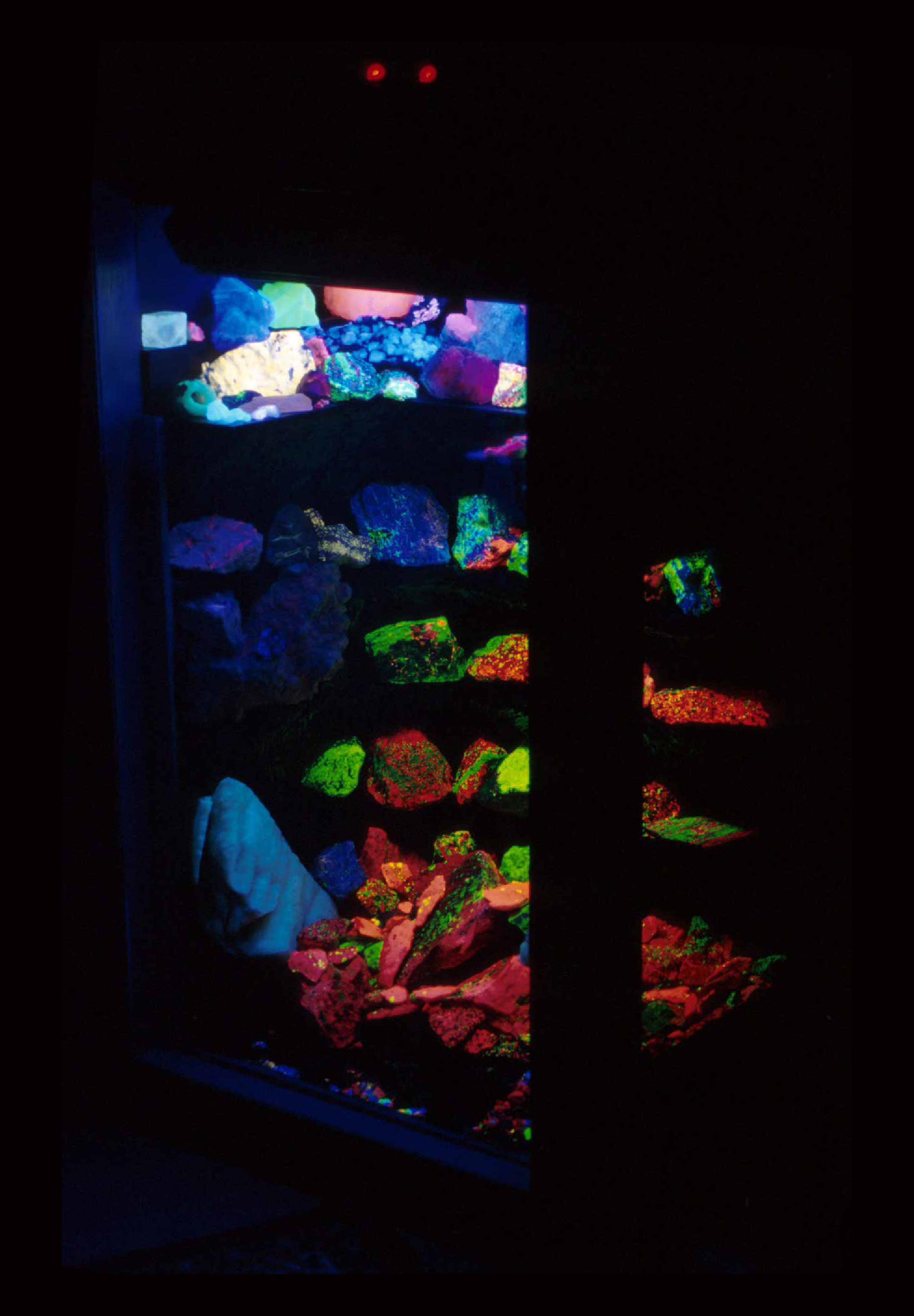

"ELECTRIC LADYLAND - the First Museum of Fluorescent Art"
FLUORESCENT MINERALS
The experience of seeing, before your eyes, a very common
gray rock burst into an array of brilliant colors is something quite
unforgettable. Photographs already amazingly portray
the mystifying appearance of dazzling colors from plain gray minerals,
but seeing this Quantum phenomenon in front of you is
another experience altogether. While most people have seen
Black Lights and Fluorescent colors for many years, very
few even realize that the source of this complete movement was
founded on the study of Nature through Geology.
About fifteen percent of all known minerals are Fluorescent
(roughly 550 minerals.) The first question that
arises when seeing this amazing phenomenon is, "Where do the Colors
come from?" The answer is pretty simple but a little
complicated. Inside the majority of Fluorescent Minerals there is
a
tiny impurity, for instance Manganese, that reacts with
the Ultraviolet energy from U.V. lamps and gives off Visible Light.
These impurities are called "Activators." What
actually happens is that the invisible Ultraviolet energy is absorbed by
the
Fluorescent Minerals and Visible Light - Colors - are
emitted from the mineral itself. The difference between the
phenomenon of Fluorescence and the normal White light
is that what we see all around us is called "Reflected Light."
The White light comes out of a bulb, hits an object,
and part of the spectrum is reflected back to your eye.
The Black Light is different. Minerals, and all
other Fluorescent substances, emit the Visible Light.
The light comes out of the mineral itself, not the light
bulb. Ultraviolet lamps give off Ultraviolet energy, which is
completely invisible. The Light comes out of the
Fluorescent Minerals, or the Fluorescent Paints and all other Fluorescent
material, not out of the U.V. lamp or Black Light.
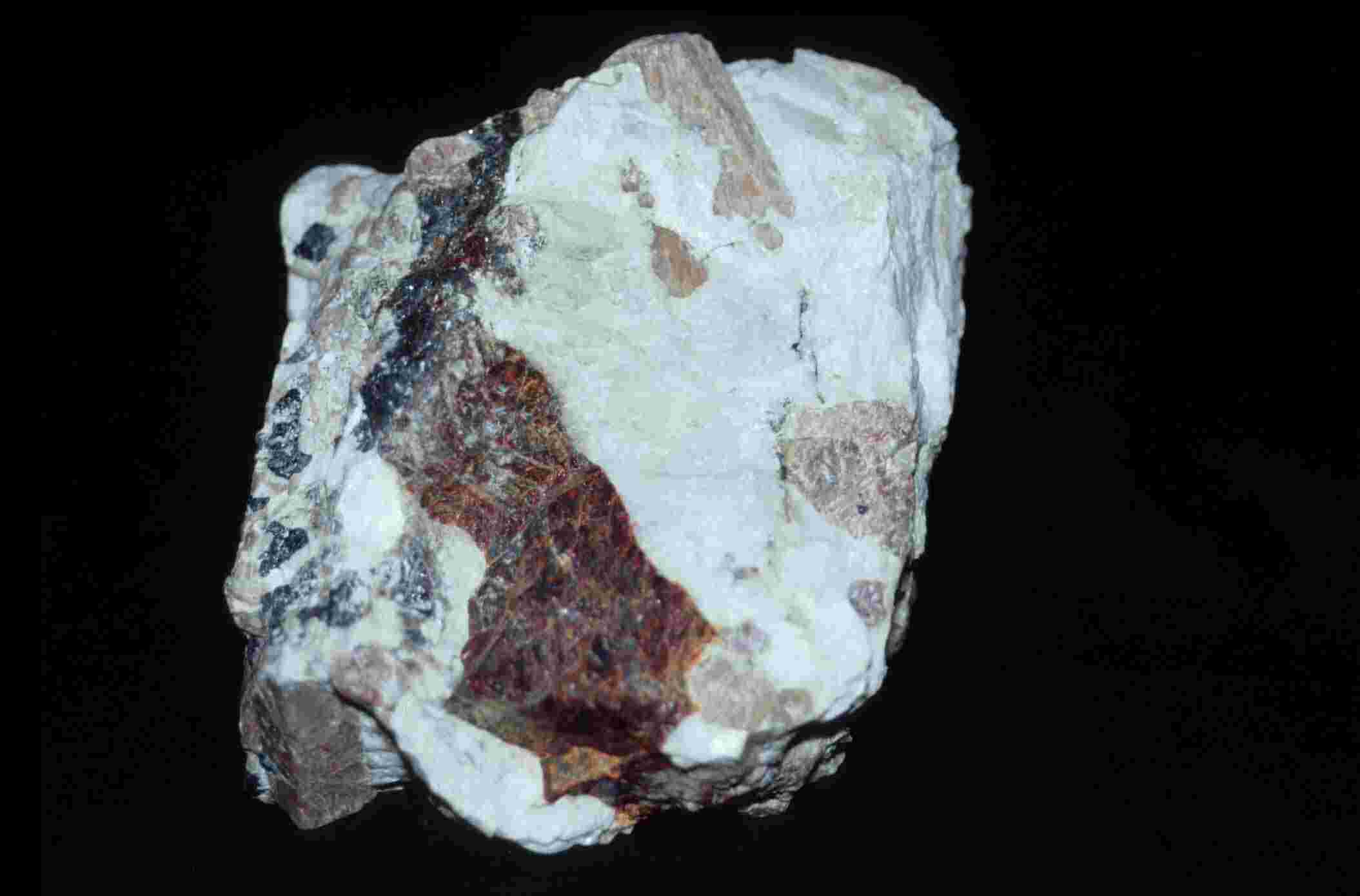

Calcite, and Willemite -
Franklin, New Jersey - White light (left) / Shortwave Ultraviolet
lamps (right)
A more complete explanation of the dynamics of Fluorescence
is a little more complex. For the Visible Light to be
emitted, the absorption of Ultraviolet energy causes
"Electron Displacement" in activator atoms, which is the movement of
electrons from their ground level in their particular
orbit, to a higher orbit, which contains more energy. At this point
the
atoms are unbalanced. To rebalance themselves,
the excited electron returns down to it's original orbit, or ground level,
and the emission of Visible Light occurs. The reason
that Invisible Ultraviolet energy is released as Visible Light is even
more complex. The electron excited by Ultraviolet
energy moves up to a higher electron orbit. The electron in this
higher
orbit looses a slight amount of it's gained energy by
dropping down through the 'sub-orbits' of it's higher energy electron
orbit. This essential reaction causes the electron
to Release slightly less energy than it Received from the invisible
Ultraviolet, so that when the bulk of the energy is released
at once from the electron dropping down to it's original orbit,
it is re-emitted with a shift into the longer, less energetic,
wavelengths as Visible Light - Colors.
In "Electric Ladyland - the First Museum of Fluorescent
Art" there are large displays of Fluorescent Minerals seen in the
White light, Longwave Ultraviolet lamps, and Shortwave
Ultraviolet lamps. There is a "Fluorescent Mineral Viewing Box"
with several hundred pounds of Fluorescent Minerals and
Crystals from all over the world, displays of Fluorescent Minerals
with Demonstrations of five different phenomenon of Luminescence
given, including Fluorescence, Phosphorescence,
Non-Linear Fluorescence, Triboluminescence, and Tenebrescence.
There are also large pieces of Fluorescent Minerals for
visitors to touch and experience the tactile qualities
of the different specimens, as well as rubbing off
beautiful colors on their fingers!
Another unforgettable experience to do with these Fluorescent
Minerals, is finding them outside in Nature in the dark
with battery-powered Ultraviolet lamps. It's a
little hard to believe, even after doing it for years. Going out
into a
gray-stoned quarry at sunset and then turning on Ultraviolet
lamps in the dark will take your breath away, especially if
you happen to be somewhere like Franklin, New Jersey.
These Fluorescent Minerals come from all over the world, but
some places have been discovered which hold vast numbers
of Fluorescent Minerals. Franklin, New Jersey is the
"Fluorescent Mineral Capital of the World" with almost
one-fifth of all known Fluorescent Minerals coming only from
Franklin. The next most famous Fluorescent Mineral
locality is Langban, Sweden. Greenland has also an exceptional
amount of Fluorescent Minerals, with brilliance and combinations
of Colors to rival even the classics from Franklin.
Canada must also be on the list of the finest localities
in the world for Fluorescent Minerals, with it's world-famous
Scapolite, and lesser known beauties coming from Parham,
a zinc-mining district of Canada.

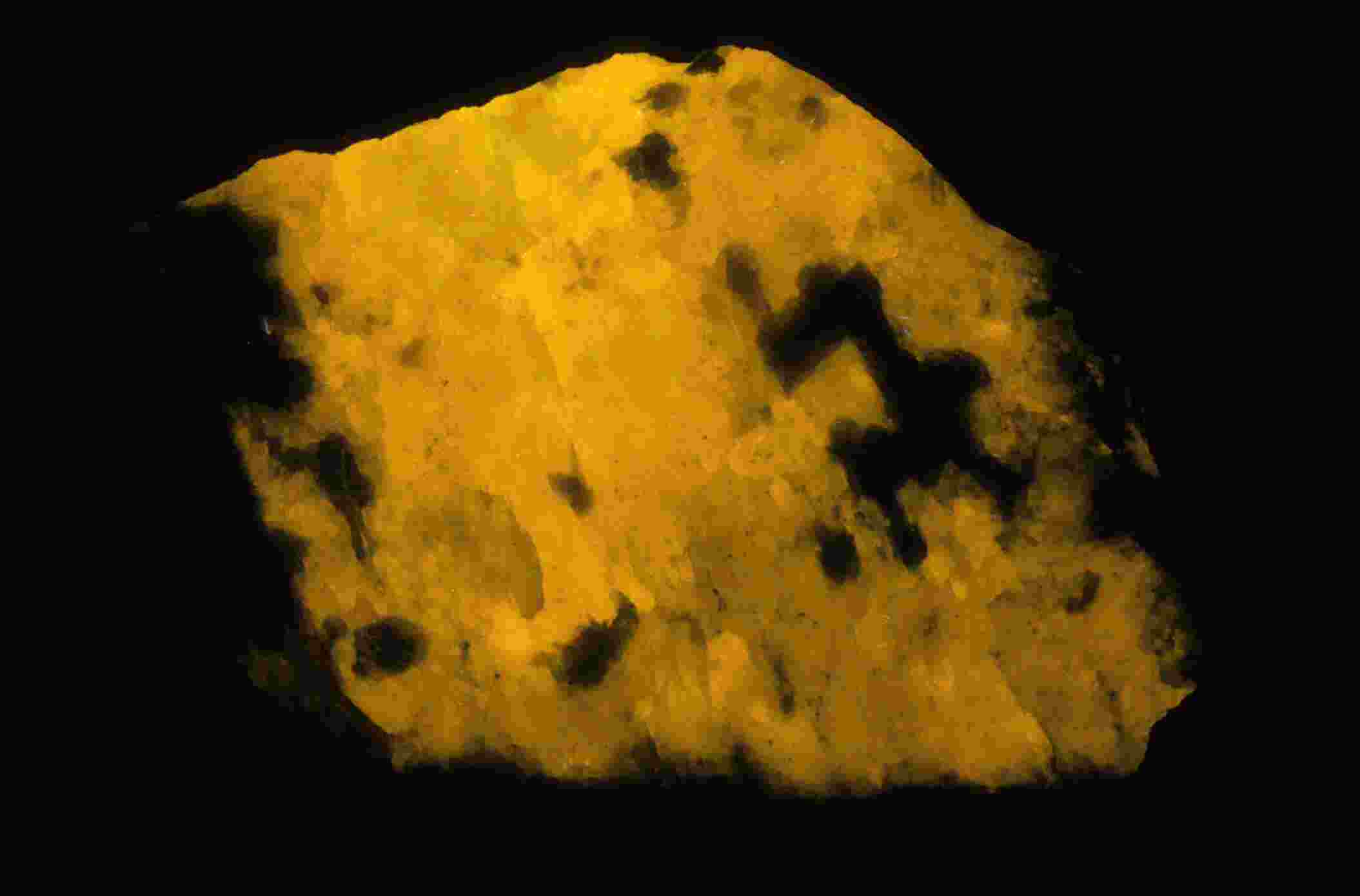
Scapolite - Bancroft, Ontario,
Canada - White light (left) / Longwave Ultraviolet lamp (Black
Light) - (right)
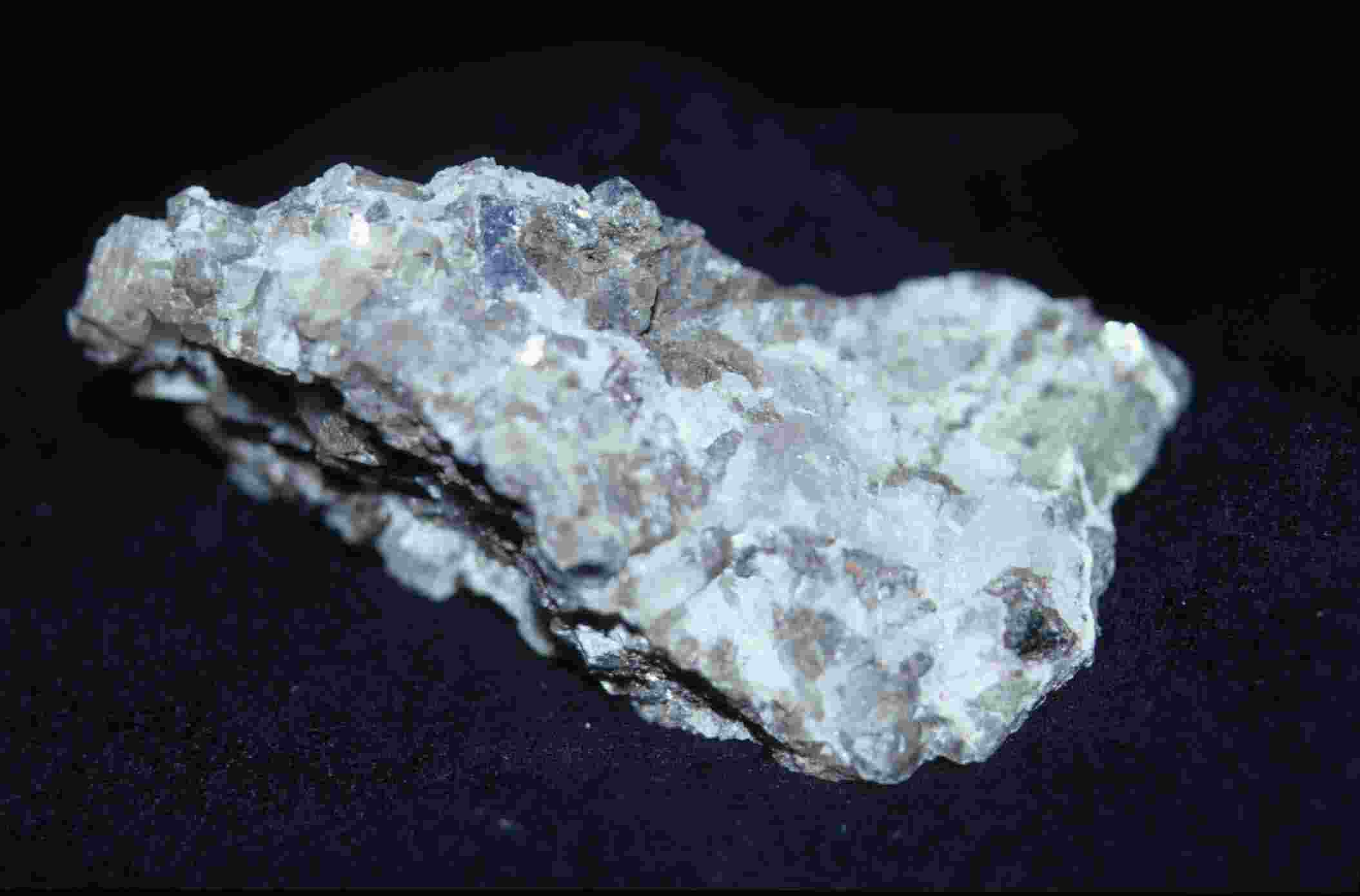
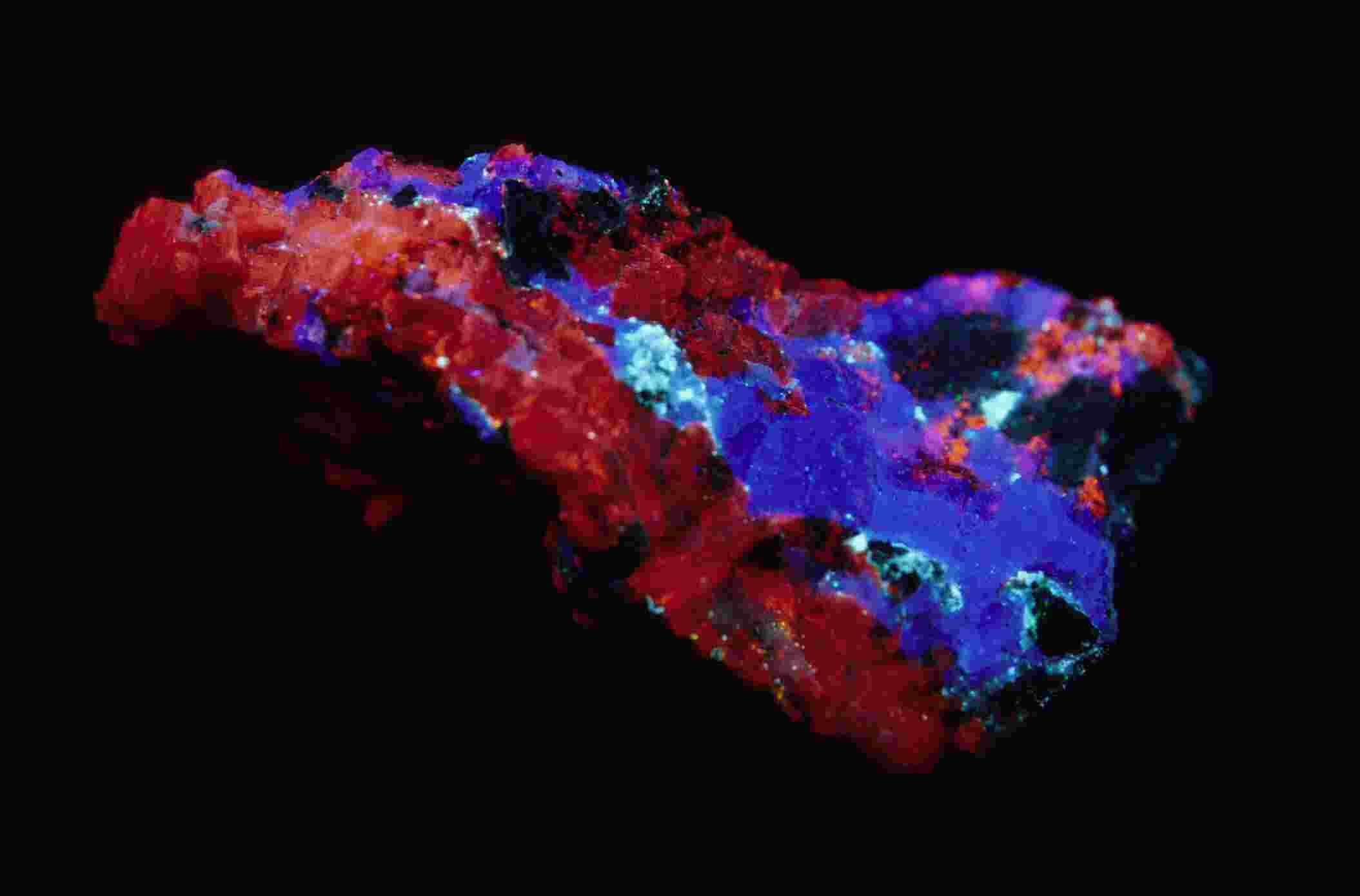
Fluorite, Calcite, and Willemite
- Tombstone, Arizona - White light (left) / Longwave and Shortwave
U.V. lamps (right)
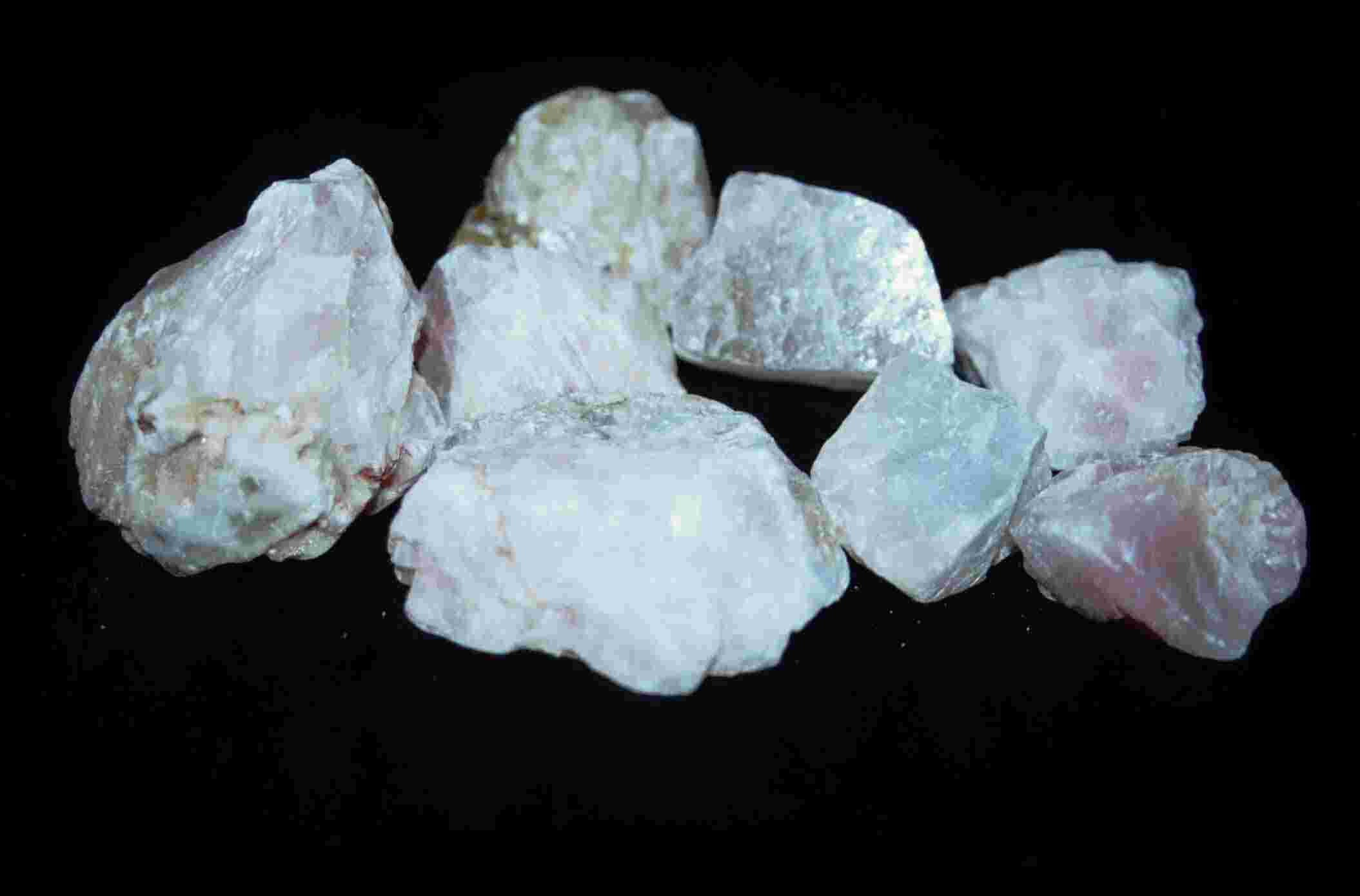
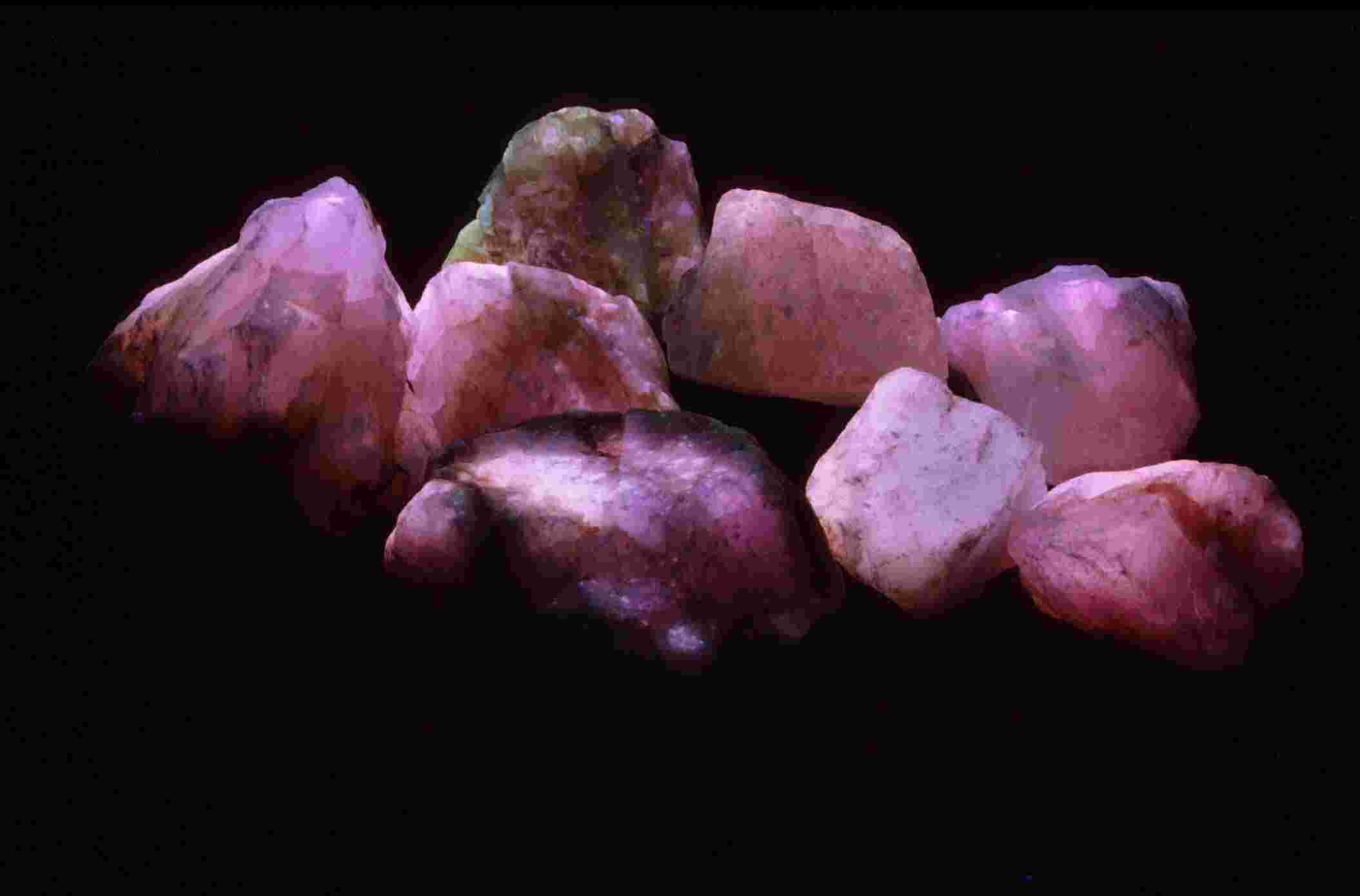
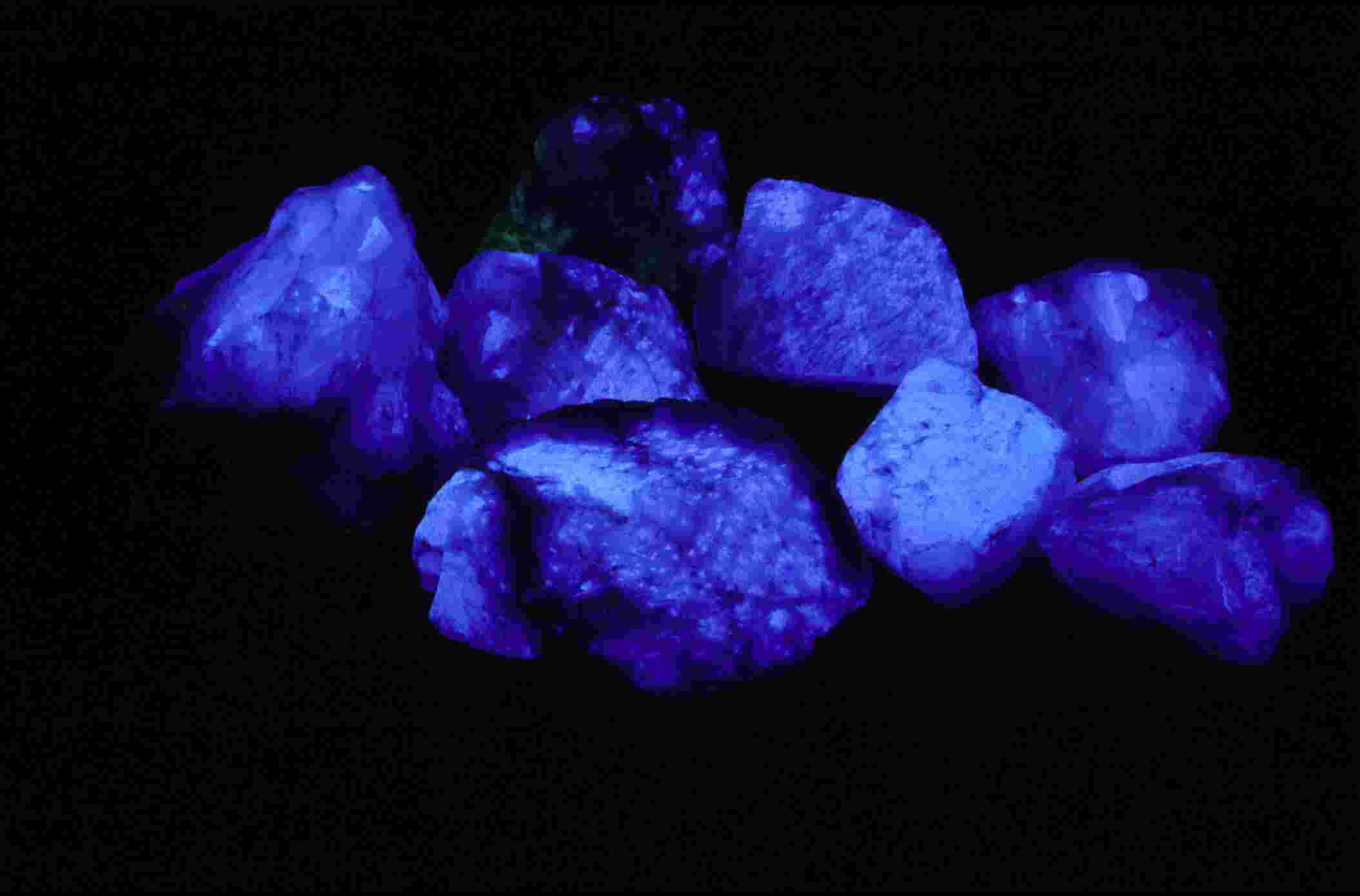
Calcite - Terlingua, Texas
- White light (left) / Longwave U.V. lamps (center) /
Shortwave U.V. lamps (right)
The First Fluorescent Minerals
Collected
in the Himalaya
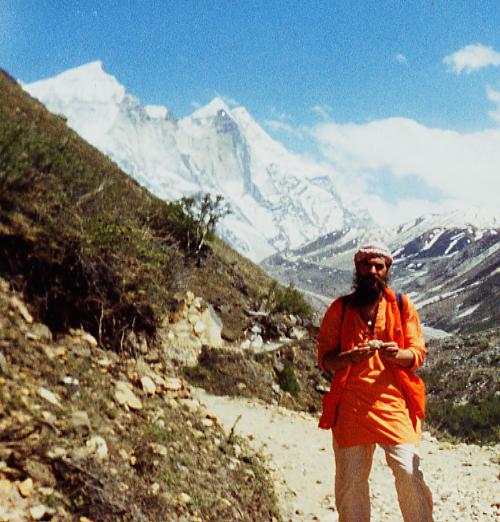
Gaumukh, India -
Source of the Ganga (Ganges river) 14,000 feet (4350
meters)
In my hands is one of the crystals
now on display in "Electric Ladyland"
At the base of the two mountains
in the distance, Shivalink Topovan,
is the source of the Ganga, coming
from beneath the enormous
Gaumukh Glacier
Fluorescent Mineral Demonstration
and Collecting in the Himalaya
From March to June, 1998, I was in Northern India for
the Kumbh-Mela in Hardwar, just south of Rishikesh. During this trip
I also went on a pilgrimage into the Himalaya where I
collected more than thirty pounds (14 kilos) of Fluorescent Minerals.
On March 27, 1998, I gave what was possibly the first
Fluorescent Mineral Demonstration in the Himalaya.
At the Santosh Puri Ashram in Saptor Rishi, Between Hardwar
and Rishikesh, I gave a Fluorescent Mineral Demonstration
to a group of about fifteen holy people, including Babaji
Santosh Puri a famous Yogi, Sadhus (Hindu priests), and Indian Babas.
This was the first time that any of them had heard about
Fluorescent Minerals, or even "Black Lights!"
Fluorescent Mineral Demonstration
in the Santosh Puri Ashram, Saptor Rishi, northern India
In my hands are Longwave and Shortwave
battery-operated U.V. lamps,
set up on the table are seven different
kinds of Fluorescent Minerals,
and at the table are Mataji, Babaji
Santosh Puri, and Mandakini
Everyone in the Ashram reacted with astonishment and much
excitement. What amazed them most was that these
seemingly common, colorless rocks burst into brilliant
colors. After the Demonstration when I turned the lights back on,
Babaji Santosh Puri picked up a gray piece of the Calcite
and Willemite from New Jersey, that he had just seen as bright
Orange and Green under my U.V. lamps, and he turned it
over in his hands, looking to see where the amazing colors had gone.
I brought both Longwave and Shortwave Ultraviolet lamps
with me for the Fluorescent Mineral Demonstration.
For the show, I brought a selection of seven different
Fluorescent Minerals to the Ashram. Fluorite from England with
blue Fluorescence, Scapolite from Canada with yellow
/ apricot Fluorescence, and red Fluorescing Mangano Calcite from Peru
for the Longwave Ultraviolet Demonstration. I also
showed a rare phenomenon of Fluorescent Minerals Changing Colors
with Terlingua, Texas Calcite, which is Pink in the Longwave
U.V. and then turns Blue in the Shortwave U.V., and when
the Shortwave U.V. lamp is turned off they all saw the
crystals Phosphorescing - Glowing -in-the-Dark!
I then showed Aragonite from Sicily which turns colors
from a Red in the Longwave U.V., to a White in the Shortwave,
and Phosphoresces a Greenish. The strongest reaction
came from the Shortwave Fluorescent Mineral Demonstration,
where I showed a six inch (15 cm.) slab and about a pound
of pieces of Calcite and Willemite from Franklin, New Jersey,
and Fluorescent Minerals with three colors from the Purple
Passion Mine in Arizona: blue Fluorite, red Calcite, and
white/greenish Willemite. At the end of the Fluorescent
Mineral Demonstrations, I also showed a small selection of
"Common Items that are Fluorescent," like Basmati
Rice, Dal (orange lentils), and Coconut, which are very common
in India. When I left india, I gave all the labeled
Fluorescent Minerals and the portable U.V, lamp to Mandakini in the
Ashram, where she still gives Fluorescent Mineral Demonstrations
with her amazing "coloring stones."
The highlight of this trip in India was a pilgrimage deep
into the Himalaya the end of May, 1998. Traveling to Gongotri,
which is in the very north of India at altitude of 10,500
feet (3350 meters), myself, Michele, and an Indian friend went on the
38 kilometer (20 mile) pilgrimage - 19 kilometers walk
to Gaumukh, and 19 kilometers back. If you walk eight more
miles beyond these two mountains Shivalink Topovan, then
you reach the border of Tibet. Gaumukh is at altitude of
4350 meters (14,000 feet) and is the source of the Ganga
(Ganges river). The Ganga comes from within the Gaumukh Glacier,
which is almost 20 miles long and two to four miles wide.
When standing in front of the advancing face of the Glacier,
where Gaumukh is, it is nearly hard to believe it is
ice - the face of the Glacier stretches 20 or 30 stories over your head,
and is about a mile wide!
At this holy pilgrimage, Gaumukh, I climbed onto this
enormous Glacier and collected three very
special Fluorescent Mineral specimens that are red, blue
and yellow under the Shortwave U.V. lamp.
On this sometimes hair-raising 38 kilometer round trip
pilgrimage to Gaumukh, I collected and carried(!) more than 30 pounds
(14 kilos) of Fluorescent minerals back. In the
finest of the 35 specimens from Gaumukh, the strongest Fluorescence is
under
the Shortwave Ultraviolet lamp. Many of the specimens
have a very particular apricot/yellow Fluorescent Mineral that is most
likely Apatite, which is famous for coming from Gilgit,
Pakistan, geographically very close.
The most interesting of the Fluorescent Minerals
I collected on the Gaumukh pilgrimage is a group of nine sparkling
crystallized pieces that are most likely Microcline,
because the specimens Fluoresce deep red under the Shortwave U.V.,
and cold Blue under the Longwave U.V.
Ten years before this, in 1988, Michele and I made our
first pilgrimage to Gaumukh, and made the
entire 38 kilometer two day round-trip walk bare-footed.
On display in "Electric Ladyland - the First Museum of
Fluorescent Art" are specimens from this Gaumukh pilgrimage,
including the brightest piece I collected, which is brilliant
green and apricot / yellow under the Shortwave U.V.
I also give Demonstrations on three pieces of the Himalayan
Microcline, which visitors see change from red
in the Shortwave U.V., to blue under the Longwave U.V.
lamps.
Michele Delage, Gaumukh, India,
14,000 feet (4350 meters) May, 1998
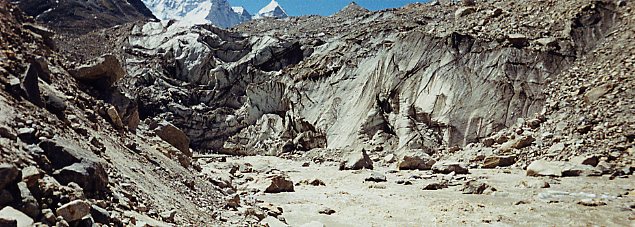
The Gaumukh Glacier, Gaumukh, India,
14,000 feet (4350 mtrs.) - The Source of the Ganga (Ganges river)
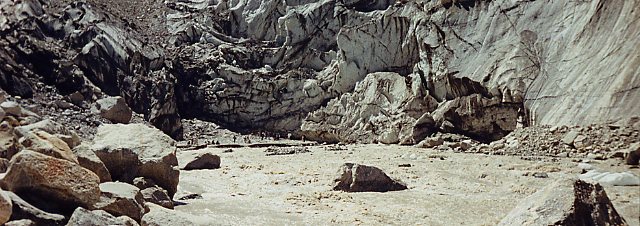
The Gaumukh Glacier, Gaumukh, India,
14,000 feet (4350 mtrs.) - The Source of the Ganga (Ganges river)
The tiny vertical specks in the
center of the photo are people, and the Ganga is the entire beige
rushing area covering the bottom
half of the photo (the beige color comes from all the sand
in the water which has just emerged
from the underworld beneath the Gaumukh Glacier).
The hugh boulders on the Ganga's
bank, at the left, is actually the "walking path!"

Nick Padalino and Michele Delage,
May, 1998, Gaumukh, India, 14,000 ft. (4350 mtrs.) - The Source of the
Ganga.
Directly behind us is a dark cave-like
opening in the Gaumukh Glacier - This is the Ganga's Source,
rushing out from the underworld
beneath the Gaumukh Glacier
Om Nama Shiva